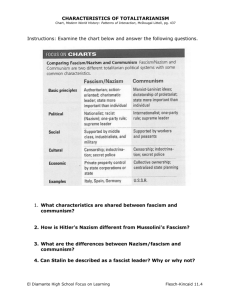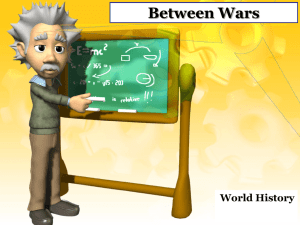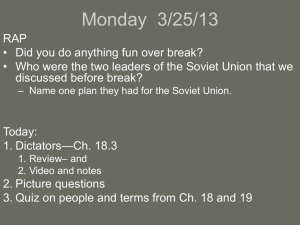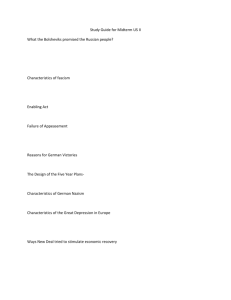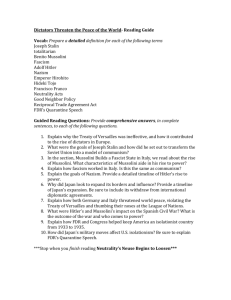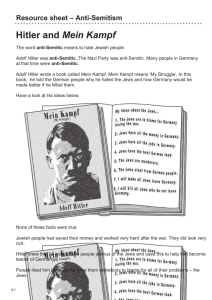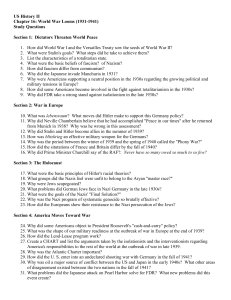Totalitarianism
advertisement
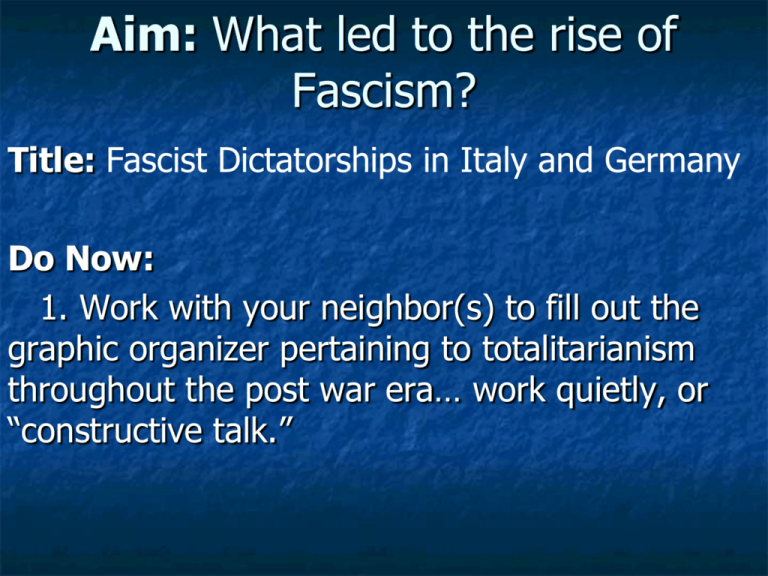
Aim: What led to the rise of Fascism? Title: Fascist Dictatorships in Italy and Germany Do Now: 1. Work with your neighbor(s) to fill out the graphic organizer pertaining to totalitarianism throughout the post war era… work quietly, or “constructive talk.” Identify/recall some of nonchalant/mundane choices make every day - i.e., music, movies, clothes, transportation, food, drink, etc. the you Now, how would you feel about a government that decided most or all of the above choices in which you made daily? Such governments are called totalitarian (TOTAL (all) I TARIAN (power or form of government in power) = dictatorship, autocrat (AUTO = self control – think of Wall-E [yes, I am referring to the movie – I did say I was corny]; CRAT = government), selfish, greedy ruler. Confused? Think in terms of the central themes stemming from George Orwell’s 1984. “ Big Brother” = government is watching your every movement… - Think of all of the surveillance cameras practically everywhere… Stores, banks, places of business, TRCS!!!!! Look at how quick the government was able to locate the two “Boston Marathon Bombers” Think about that. Other forms of leadership/government you ought to know: Theocracy: THEO (God/deity) + CRACY (form of government/authority) = Government orchestrated/ruled by religious leaders/clerics. Ex: think in terms of Persepolis or the Pope and the Oligarchy (OLI = few/small group) + GARCHY (form of government/authority) = form of government where are strong/influential/wealthy few or group have all or most of the power. Plutocracy (PLUTO = wealthy/elite group) + CRACY (form of government/authority) = government by wealthy/elite group. What is it? Describe its characteristics… Extreme Nationalism Total Control of State by a Dictator Deny Individual Rights - Supremacy of The State Increasing influence of new political parties that emphasize state control -For example: Communism, Nazism, Fascism Government establishes complete control of all aspects of the state (political, military, economy, social, cultural) Highly nationalistic (flags, salutes, rallies, uniforms) Strict controls and laws Military state (secret police, army, military) Censorship (to examine printed materials to ban or delete information) Propaganda (media – radio, newspapers, posters) One leader (dictator); charismatic Authoritarian (requiring absolute loyalty and obedience to the state Terror and Fear What is Totalitarianism? Totalitarianism: a system of government in which a leader (dictator) has complete control over his country and the lives of his people Key Traits of Totalitarianism Dictator: strong leader with total power One party: ruling party is the only legal political party Strict government control of all aspects of life business, religion, the arts, education, etc. use of propaganda, censorship, terror, and secret police to control people Individuals have very few freedoms No freedom of speech, religion, press, etc. Why Europe in the 1920’s and 1930’s? Countries had no tradition of selfgovernment before WWI – the new selfgovernment was forced upon nations not ready for it 1930’s saw a world wide depression, making struggling democracies face more problems Slide 11 Totalitarian Leaders Why did they come to power? People wanted strong leaders to get them out of the Great Depression Nationalism—they promised to make their countries big and powerful What did they want? Total control over country and people Strong military and economy More land—they were willing to go to war for it! Compare & Contrast the two: Fascism vs. Nazism 1. What is Fascism? Fascism Fascism—a system of government based on extreme Nationalism. Nazism—a version of fascism that developed in Germany. Hitler added racism. Characteristics of Fascism/Nazism; 1. The state is more important that the people. 2. Individuals have no rights. Opposition suppressed by force. 3. Nation should have strong leaders with absolute power. 4. Reactionary (act first think later), irrational. 5. Not an economic theory. Private property is protected. Property owners have to do what the state orders. Communism is a hated enemy. 6. Have tended to be extremely militaristic. Shown by building up armies, leaders appearing in Uniform, favor military virtues of loyalty, obedience, order. Fascist ideology & Mussolini Italian dictator Benito Mussolini coined the term in 1919, referring to the Roman symbol for “power through unity” – a bundle of reeds called “fasces,” individually weak but collectively strong. Fasces: Symbol of Power in Ancient Rome Find the Fasces – Symbol of Civic Authority In The U.S. House of Representatives I am Benito Mussolini the leader (Il Duce) of Italy from 1922 to 1943. First European fascist dictator of Italy What is Fascism? • intense nationalism and elitism • totalitarian control • interests of the state more important than individual rights • maintain class system and private ownership Fascist Model Power State = Here eternal, lasting State casts aside all who do not serve its purpose The State I I Individual = temporary, expendable I I I Individual exists to serve the State (a Slide 19 Democratic Model Power Here Individual is most important I I I The State I I State serves the individual and may be replaced as expendable if it violates personal right to life, liberty, property Slide 20 Fascist Principles Anti-individualistic Anti-democratic Anti-egalitarian Anti-capitalist Anti-pacifist Anti-internationalist Anti-conservative Anti-intellectual Anti-Socialist/Communist How does Mussolini gain popularity in Italy? 1. 2. 3. 4. People are disappointed over the failure to win territorial gains in the Paris Peace conference after WWI Inflation is rising and people want help Unemployment is increasing and people want it FIXED! The people were looking for someone to take action What did Mussolini do once he was in power in Italy? 1. 2. 3. 4. MADE BIG PROMISES to revive the economy and rebuild the armed forces Founded the fascist party Criticized the current government Gained the support from the middle class, artisans and the Industrial leaders Results with Mussolini in Charge in Italy: 1. 2. 3. 4. 5. 6. Abolished democracy Outlawed political parties Established his own secret police Censored the radio, all publications, Outlawed strikes Allied with Industrialists and large land owners against the “little guys” What did Mussolini do once he was in power in Italy? Italians constantly threatened violence and uprising if things didn’t change Mussolini had the support of the popular vote so King Victor Emmanuel III puts Mussolini in charge of the government Two Types of Totalitarianism: Fascism & Nazism Fascism nationalism – the nation is more important than the individual Charismatic leader – big personality, good public speaker, inspires people Different social classes – rich, middle class, poor Anti-communism Extreme I am Adolf Hitler the leader (der Fuhrer) or dictator of Germany from 1933 to 1945. What is Nazism? German fascism • extremely fascist , nationalistic and totalitarian • based on beliefs of the National Socialist German Workers Party • belief in the racial superiority of the Aryan, the “master race” • belief that all Germans should have “lebensraum” or living space in Europe •Violent hatred towards Jews and blamed Germany’s problems on them Nazism Fascism taken to its extreme form. Racist and anti-Semitic elements that did not appear in Italian fascism. • GESTAPO: the Secret State Police • SS (Schutzstaffel): Defense Corps “black shirts”, an elite guard unit formed out of the SA • SA (Sturmabteilung): Stormtroopers (STAR WARS!!!!) "brown-shirts" early private Nazi army that protected leaders and opposed rival political parties • Lebensraum (living space): concept that emphasized need for territorial expansion of Germany into east • Wehrmacht: German army • • Einstazgruppen: Nazi Death Squad; mobile killing units Anti-semitism: Hostility and discrimination against the jews Territorial integrity: Territorial domain of a State Armed Aggression: Military invasion, a War of conquest Mein Kampf (1924) The title means My Struggle, and it expounds on Hitler’s anti-Semitism, worship of power, scorn for morality, and plan for world domination. Hitler wrote it in prison after a failed attempt to overthrow the German government Questions from Mein Kampf What is his central point in the selection you read? Questions from Mein Kampf That the blood of the highest race must be kept pure from intermingling with other races if human culture is to advance; corruption of blood leads to the destruction of culture. Nazi racial theory Three races: Aryans (Germanic) – culture creating Jews – culture destroying Middle – culture maintaining At various levels of hierarchy between Aryans and Jews. Nazi racial theory The belief that Germans were threatened the most from an internal enemy led to the Holocaust, the extermination of 6 million Jewish people in Europe. Everything was sublimated to the need to purify the German race. In fact, it even drove Nazi policies that worked against the war effort. Genocide Nazi extermination of the Jews is considered to be Genocide - the systematic extermination of a whole people or race. The U.S. government has called the killing of Sudanese in Darfur by governmentsponsored militia a “genocide.” Nazi racial theory Hitler wrote, “The Jew has always been a people with definite racial characteristics and never a religion.” To him, the Jewish religion is not the problem. If their religious faith is not a threat, why should Non-Jews worry about Jews? The Jewish “Problem” Seek to pollute Aryan blood. Cunning (not smart), with strong will to survive. Seek to destroy higher cultures. Not “idealistic;” no selfless or noble attitudes. No original contributions to art or science. In league with communists. Betrayed German state during WWI. Not human but subhuman. Questions from Mein Kampf How did Hitler make the argument about racial superiority? Questions from Mein Kampf 1. Natural law: “one of the most patent principles of Nature's rule: the inner segregation of the species of all living beings on this earth.” 2. History: historical experience offers countless proofs, e.g., the purity of the race in North America has led to greater achievements than in Central & South America. 3. Religion: “sin against the will of the creator. He refers to a sin against the will of eternal Providence.” Questions from Mein Kampf What metaphors does Hitler use to refer to the Jewish people? Questions from Mein Kampf a horde of rats parasites in the body of other peoples subhuman MEIN KAMPF : Book written by Hitler, set his ideas and goals: Germans were a master race, that jews , latins, black people, gypsies, Homosexuals, were inferior and should be destroyed LEBENSRAUM: living space for Germans VERSAILLES TREATY : should be destroyed Both Totalitarian dictatorship – required absolute obedience to leader Anti-democracy Extreme militarism – glorification of military Germany Leader Adolf Hitler (1933-1945) Government Fascist Political Party Nazi Party (National Socialist German Workers’ Party) Policies/goals Extreme German nationalism Anti-Semitism (hatred of Jewish people) Anti-communism Fix economy -Create jobs with public projects Rebuild German military Create a powerful German Empire Italy Leader Benito Mussolini (1922-1943) Government Fascist Political Party Fascist Party Policies/goals Extreme nationalism -Make Italy a powerful nation -Build Italian Empire Fix economy Restore order Support Catholic Church Anti-socialism Anti-communism Adolph Hitler Hitler considered himself superior, eventhough he was a drifter & failed artist during his youth. A corporal during WWI, he was devastated by Germany’s loss & blamed it on the Jews. He started his political career at age 30, joining the German Workers Party. He had exceptional speaking skills & came to be revered by others in the party. He was chosen its leader in 1921, and renamed it the National Socialist German Workers Party. ENABLING ACT: Act that Gave Hitler Absolute Power in Germany for four Years- This Nazi propaganda poster reads, ‘Behind the enemy powers: the Jew. Nuremberg Laws: Deprived jews of german citizenship and rights “The Eternal Jew” Posters like this promoted a sharp rise in antiSemitic feelings, and in some cases violence against the Jewish community. Kristallnocht: The beginning of the nazi persecution of jews kristallnacht • Kristallnacht— November 9, 1938—”Night of Broken Glass”— Jewish shops, synagogues, homes violently attacked—after a Jewish teenager from Germany shot a German diplomat in Paris—beginning of mass emigration of Jews and the forced removal to Jewish ghettos
